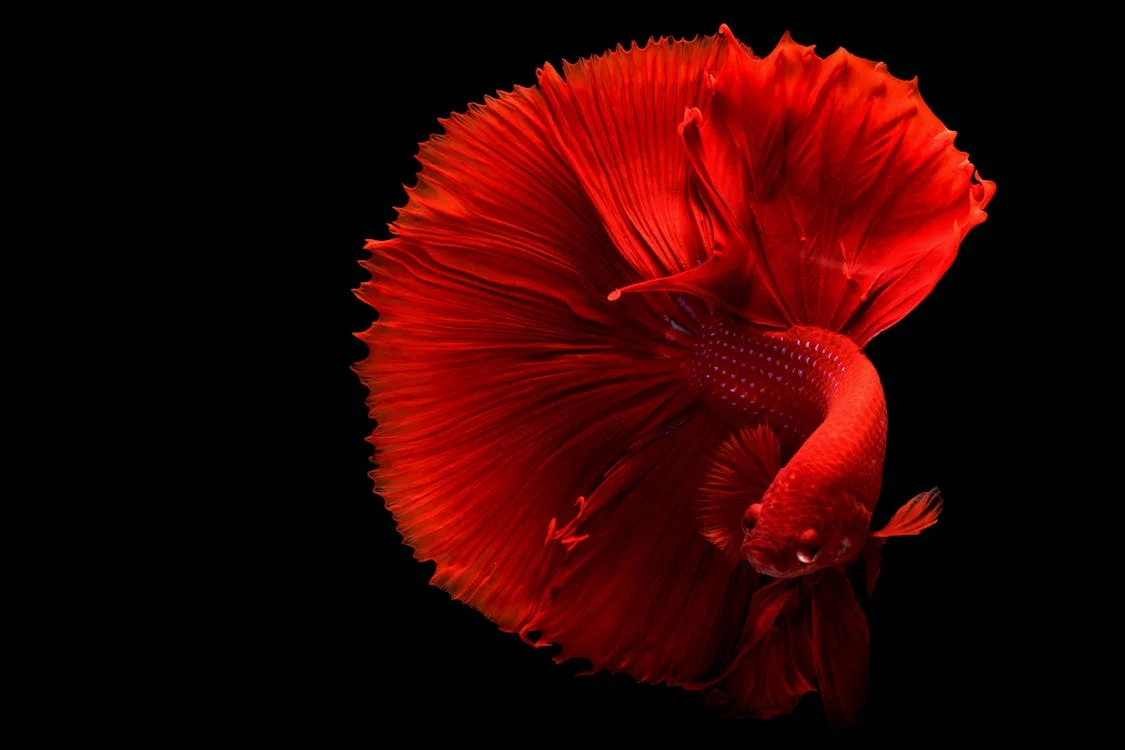
Betta Fish are known to be territorial and even aggressive. As I considered adding bettas to my community tank, I wondered what normal betta behavior looks like and how male and female bettas differ in their personalities. I also want to know if Siamese fighting fish can live with other bettas and other species. Are there any betta kinds that are more aggressive than others?
Females bettas do well in groups of five or more, with or without one male, in a 10+ gallon tank. However, avoid keeping two or more male bettas in one tank. Bettas do well with shrimp, snails, simple guppies, neon tetras, and calm bottom-dwelling fish, such as loaches and corydoras. Complex decorations, hiding spots, and optimal water conditions reduce aggressive behaviors in bettas.
The first step is understanding normal betta behavior and why Siamese fighting fish are aggressive.
Can Bettas Live Together?
It is best to avoid placing two or more male bettas in one tank, even if the tank provides ample room. Females, however, can cohabitate peacefully. One male and a group of females can be a successful combination but the male might still be very territorial and aggressive.
When the females in a group first meet, they might nip, chase each other, and exhibit other aggressive behaviors.
Fin flaring as a sign of aggression is a common behavior at this stage. Such aggressive behaviors are normal and are a part of establishing dominance and social order, and figuring out their roles in the group. As time passes, female bettas get used to each other and live peacefully.
Keeping at least four or five females together is helpful because it diffuses aggression and prevents any one fish from being bullied excessively.
Although a group of females usually lives peacefully, each fish has its personality and can assume different roles. If you notice that a single fish attacks more or is attacked a lot by others, the specimen may need to be separated and placed into a separate tank.
Can Betta Fish Live With Other Fish, Snails, and Shrimp?
It is possible to keep female bettas with other fish and aquatic pets but choose the tank mates carefully to avoid altercations and bullying.
Water parameters have to be suitable for bettas and other species. Optimal conditions keep everyone healthy and promote peaceful cohabitation.
Quarantine the new species in a separate tank for a few weeks to avoid introducing parasites and harmful bacteria.
Be prepared to separate bettas from the other species if the introduction does not go well – have a second tank available and ready just in case.
- A small school of single-gender guppies is a great choice. Choose simple feeder guppies, not fancy guppies or another long-finned kind of guppies, to avoid triggering your bettas.
- A school of neon tetras and ember tetras can also be a good addition.
- Corydoras catfish, especially panda corydoras, are easy to maintain, not competitive, timid, and entirely bottom-dwelling, which makes them ideal tank mates for bettas.
- Loaches are bottom-dwelling and spend most of their time hiding, which makes them a good non-competitive match for bettas.
- Glass, ghost, and red cherry shrimp: They do not interfere with bettas’ movements and generally do not conflict with bettas. However, bettas can prey on small shrimp, so it is important to add shrimp that large. You should also observe the interactions of bettas and shrimp. If your betta fish attempt to bully and attack shrimp, you might need to isolate the shrimp from the fish.
- Snails, particularly Malaysian trumpet snail: Snails stay out of bettas’ ways and have a shell to protect them from a betta’s excessive attention as needed.
If you are considering adding snails to your aquarium, please read our post on the Interactions of Snails and Bettas.
What Is Normal Betta Fish Behavior?
Bettas are active, curious, fairly interactive, and even trainable, as far as pet fish go. Each fish can have a very distinct personality. Bettas can recognize their owners and respond to their presence.
Betta fish like to explore new items in their tank and are curious about any new fish added to the aquarium.
Bettas are famous for their feisty and aggressive behaviors, although betta fish in the wild are less aggressive than their captivity counterparts. One reason is that these fish have more space and resources in their natural habitats and less competition for food and territory than in a confined aquarium.
Bettas do not normally eat other fish in tanks or the wild, although they can swallow or even intentionally costume smaller fish in some situations. We posted about bettas’ fish-eating behaviors if you want to know more about the issue.
Why Are Bettas So Aggressive?
Although Siamese fighting fish are normally dynamic and feisty, their aggressive trait might have been bred for when they first emerged as pet fish.
Villagers liked watching these fish fight and interact, and more aggressive bettas were selected for breeding. Bettas were pitted against each other in fighting matches for people’s entertainment.
Of course, it is important to avoid placing aggressive fish in one habitat as they can harm and even kill each other.
Male Betta Fish Personality
Male bettas are territorial, hyper-vigilant, and can be considered aggressive specimens. They do well alone or in the company of one or more female bettas.
Female Betta Fish Personality
Females are typically more docile than males but they too are feisty. Females live well in a group of other female bettas with or without a solo male betta.
Signs of Aggression in Betta Fish
Common signs of aggression in bettas include the following:
- Chasing others
- Nipping
- Fin and tail flaring
- Flaring or erecting gill covers
- Side-to-side tail beating
Interestingly, bettas, particularly males, can express aggression toward stimuli other than fish. They can act aggressively toward their reflection in the mirror, for example.
Which Betta Fish Are More Aggressive?
Blue-finned male bettas are more aggressive and display signs of confrontation, such as fin flaring, for longer periods than others.
Plakat bettas are also generally known to be more aggressive. They are stout, and quick and have shorter, more compact, fins and tails, which helps them evade the attacks of others.
Which Bettas Are Less Aggressive?
Betta imbellis (crescent betta), also known as the peaceful betta, is not among the popular kinds of betta fish but they are beautiful and have a distinctive crescent-shaped tail with a black rim. These fish grow up to 6 cm (2.4 in) and are relatively hardy.
Betta imbellis are generally less aggressive and territorial. They are well suited for escaping others’ aggression due to being alert and quick.
Who Cannot Live with Betta Fish?
Avoid adding fish of bright colors or fish with long, luxurious tails to a tank with bettas. Bright colors and long tails can trigger aggression in bettas.
Other aggressive, territorial fish that can attempt to fight betta should not be added to the aquarium.
Siamese fighting fish do well with fish and other organisms that live on the bottom of the tank and do not spend much time in the middle and upper portions of the aquarium. Bettas are top-dwelling fish, so they need that space for themselves.
Some popular fish that are a bad match for betta fish include the following:
- Goldfish
- Gouramis
- Angelfish
- Tiger barbs
- Puffers
Avoid adding reptiles and amphibians to your betta fish tank.
How to Reduce Aggressive Behaviors in Betta Fish
Strategic group selection and a wise selection of decorations can create a peaceful Betta community.
A group of four or five female bettas, with or without one male betta, is a good combination for an aquarium that is 10 gallons or more.
Whether you would like to keep bettas separately from others or keep bettas in a community tank, providing ample space in the aquarium, ideal water parameters, and plenty of hiding spots and items to explore are important components of a peaceful aquarium.
Natural or artificial plants are great additions. Betta fish need complex decorations and environments to prevent boredom and allow for exploration and hiding as needed.
Bettas benefit from a large surface area, so your aquarium should be wide rather than tall.
It is best to avoid placing a mirror permanently in the tank because it can be stressful for many fish, not just bettas. Male bettas, in particular, can be very aggressive toward their reflection, so the fish might get stressed out after some time. A mirror can provide a good activity for bettas and other fish but only on occasion, not regularly.
To Conclude
Bettas are among the most popular species of pet fish due to their beautiful looks, strong personalities, and complex behaviors. They can also be quite high-maintenance, particularly when it comes to their interactions with each other and others.
Finding the right approach to your bettas is worth the effort. Your aquarium will be a pleasure to observe whether you have one betta, several bettas, or bettas living in a community tank.
Related Question:
Generally, you should avoid petting your betta, or any other pet fish, because you could accidentally damage the slime coat and change the bacterial composition on its skin. Unlike mammals, fish also do not like being petted. To prevent causing stress to your fish, choose non-contact ways to play with it and avoid touching your betta unless needed for care.
Recent Posts
Guinea pigs have excellent hearing, especially at high frequencies. They are more sensitive to high-pitched sounds than people. These pets should not be exposed to sounds loud enough that you would...
Guppy fish Dwarf gourami Choosing the right tank mates is so important for a peaceful community aquarium. Can guppies and dwarf gouramis live in one tank? Dwarf gourami and guppies can live...

